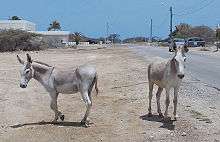Nubian wild ass
| Nubian wild ass[1] | |
|---|---|
 | |
| Nubian wild ass at Berlin Zoo, 1899. | |
| Scientific classification | |
| Kingdom: | Animalia |
| Phylum: | Chordata |
| Class: | Mammalia |
| Order: | Perissodactyla |
| Family: | Equidae |
| Genus: | Equus |
| Species: | E. africanus |
| Subspecies: | E. a. africanus |
| Trinomial name | |
| Equus africanus africanus (von Heuglin & Fitzinger, 1866)[2] | |
| Synonyms | |
| |
The Nubian wild ass (Equus africanus africanus) is the nominate subspecies of African wild ass, and one of the ancestors of the domestic donkey, which was domesticated about 6,000 years ago.[3][4] It is presumed to be Extinct, though two populations potentially survive on the Caribbean island of Bonaire and in Gebel Elba.
Description
According to Groves & Chubb, Nubian wild asses had longer ears than the Somali wild ass, ranging from 182-245mm in length.[5] These animals also possessed the "cross-pattern" famous in domestic donkeys but absent in the Somali subspecies, and lacked the "zebra-stripe-pattern" on the legs as found in Somali specimens.
Habitat and distribution
Nubian wild asses lived in the Nubian Desert of northeastern Sudan, from east of the Nile River to the Red Sea and south to the Atbarah River and northern Eritrea.[1]
Extinction & potential survival

The Nubian wild ass hasn't been seen since the 1950s-70s and is presumed extinct.[6] The last sighting of wild asses in the animal's range were in Eritrea's Barka Valley and the border between Eritrea and Sudan during aerial flights in the 1970s.[1] Similar to the decline of the Somali wild ass, the Nubian wild ass' extinction can largely be attributed to hunting, competition with livestock for limited desert resources, and hybridization with the Domestic donkey.[7]
In 2014/2015, a mitochondrial DNA analysis was conducted on a population of feral donkeys on the Caribbean island of Bonaire. The study included DNA samples from the Bonaire animals, museum specimens of Nubian wild asses, sequences from four Somali wild asses, and a sequence from one Domestic donkey, used as a control. The results found that the Bonaire animals were very close to known pure Nubian wild asses and very different from other asses. However, research published in 2010 found that modern donkeys are descended from two lineages of wild ass, one being Nubian and the other being of unknown ancestry.[8] This being the case, the fact that only one donkey was used in the test suggests that the findings are rather inconclusive. For more conclusive results to be found, more testing must be completed with a larger group of donkeys. Additionally, the analysis was a result of an outcry over the government of Bonaire planning a cull of the feral animals, leading to the possibility of the results being slightly biased towards shutting down the cull.[9]
The Gebel Elba National Park, near the border of Egypt and Sudan, is claimed to be home to a wild population of Nubian wild asses. However, the purity of the animals in question has yet to be studied.
References
- 1 2 3 "Equus africanus". IUCN Red List of Threatened Species. Version 2015.2. International Union for Conservation of Nature. 2015. Retrieved 28 April 2016.
- ↑ (German) Heuglin Th. v & Fitzinger L. J. (1866). "Systematische Übersicht der Säugethiere Nordost-Afrika’s mit Einschluß der arabischen Küste, des rothen Meeres, der Somáli- und der Nilquellen-Länder, südwärts bis zum vierten Grade nördlicher Breite. Von Dr Theodor v. Heuglin. Nach brieflichen Mittheilungen und den Original-Exemplaren des Herrn Verfassers ergänzt und mit Zusätzen versehen von dem w. M. Dr Leopold Joseph Fitzinger". Sitzungsberichte der Kaiserlichen Akademie der Wissenschaften, Abt. 1. Mathematisch-Naturwissenschaftliche Klasse 54: 537-611.
- ↑ http://www.edgeofexistence.org/mammals/species_info.php?id=13
- ↑ Wynne Parry, Wynne (July 29, 2010). "Donkey's Wild Ass Ancestor Confirmed". Retrieved 15 November 2014.
- ↑ http://www.zoochat.com/2/nubain-wild-ass-zoos-306367/#post636897
- ↑ https://books.google.com/books?id=M6NI2FejIuwC&lpg=PA38&ots=pcVyEHExgi&dq=nubian%20wild%20ass%201950%27s&pg=PA38#v=onepage&q&f=false
- ↑ http://www.edgeofexistence.org/mammals/species_info.php?id=13
- ↑ http://rspb.royalsocietypublishing.org/content/royprsb/early/2010/07/26/rspb.2010.0708.full.pdf
- ↑ https://retrieverman.net/2015/02/26/are-the-bonaire-donkeys-the-last-wild-nubian-asses/
.jpg)